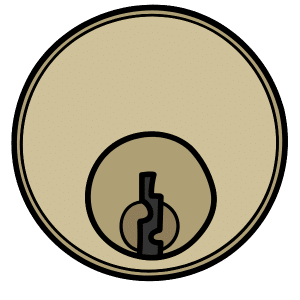Lock Repair 101: Types & Repair Processes
Locks are an essential component of residential and commercial security, providing protection and peace of mind. However, like any mechanical device, locks can experience issues that require repair and maintenance. In this comprehensive guide, we will delve into the various types of locks commonly found in residential and commercial settings, understand their working mechanisms, discuss common issues, and provide step-by-step repair processes. Additionally, we will emphasize the importance of proper maintenance and offer practical advice on when to seek professional help.
Types of Locks
1. Deadbolts
Working Mechanism: Deadbolts are single or double-cylinder locks that extend a solid metal bolt into the door jamb and strike plate, providing strong resistance to forced entry.
Common Issues: Deadbolts can experience issues such as jamming, misalignment, or key breakage.
Repair Process:
- To repair a jammed deadbolt, lubricate the bolt and internal components with graphite-based lubricant.
- If the deadbolt is misaligned, adjust the strike plate or the deadbolt mechanism to ensure proper alignment.
- In case of key breakage, carefully remove the broken key using needle-nose pliers.
2. Knob Locks
Working Mechanism: Knob locks are commonly found on residential doors and have a spring-loaded latch mechanism that retracts when the correct key is turned.
Common Issues: Knob locks may suffer from loose knobs, worn-out latches, or internal mechanism failure.
Repair Process:
- Tighten loose knobs using a screwdriver.
- If the latch is worn out, replace it with a new latch assembly.
- Lubricate the internal mechanism to ensure smooth operation.
3. Lever Handle Locks
Working Mechanism: Lever handle locks are often used in commercial settings, featuring a lever instead of a knob for easy access.
Common Issues: Lever handle locks can experience issues such as loose levers, misalignment, or internal mechanism failure.
Repair Process:
- Tighten loose levers and screws using appropriate tools.
- Adjust the strike plate if the lock is misaligned.
- Clean and lubricate the internal mechanism to prevent sticking.
4. Electronic Locks
Working Mechanism: Electronic locks utilize electric current and digital codes or keycards for access.
Common Issues: Electronic locks may encounter power failures, programming errors, or keypad malfunctions.
Repair Process:
- Check the power source and replace batteries if necessary.
- Reset the lock’s programming according to the manufacturer’s instructions.
- Clean the keypad and contacts to ensure proper functionality.
Importance of Maintenance
Regular maintenance and inspections are crucial to prevent lock-related problems. This includes cleaning, lubrication, and periodic checks for worn components or signs of damage.
Seeking Professional Help
While many lock issues can be addressed through DIY repair, complex issues or those related to electronic locks may warrant professional assistance. A qualified locksmith can provide expert diagnosis and repair for a wide range of lock-related issues.
Reliable Locksmith Services
When seeking professional locksmith services, it’s essential to choose a reputable and reliable provider. Look for locksmiths with proper licensing, certifications, and positive customer reviews to ensure quality service and peace of mind.
In conclusion, understanding the different types of locks, their working mechanisms, common issues, and repair processes is essential for maintaining the security and functionality of residential and commercial properties. By following proper maintenance practices and knowing when to seek professional help, property owners can ensure that their locks remain in optimal condition, providing effective security and access control.
FREQUENTLY ASKED QUESTIONS
What are the different types of locks commonly used?
Common types of locks include deadbolts, padlocks, knob locks, lever handle locks, mortise locks, cylinder locks, and smart locks.
How do I know which type of lock is suitable for my needs?
The choice of lock depends on factors such as the type of door, level of security required, budget, and personal preferences. Consulting with a locksmith can help determine the most appropriate lock for your specific situation.
What are the signs that my lock needs repair?
Signs that a lock may need repair include difficulty turning the key, a loose or misaligned lock mechanism, rust or corrosion, and visible signs of damage or wear.
Can I repair my own locks, or should I hire a professional?
While minor lock repairs can be done DIY, such as tightening loose screws or lubricating the mechanism, complex issues or damage may require the expertise of a professional locksmith to ensure proper repair and security.
What are the steps involved in repairing a lock?
Lock repair processes may vary depending on the type of lock and the specific issue. Generally, it involves diagnosing the problem, disassembling the lock if necessary, replacing damaged components, and reassembling the lock.
How can I prevent future lock issues and prolong the lifespan of my locks?
Regular maintenance, such as cleaning and lubricating the lock mechanism, tightening loose screws, and addressing minor issues promptly, can help prevent future problems and extend the lifespan of your locks.
Are there any special considerations for repairing smart locks?
Repairing smart locks may require additional technical knowledge and expertise due to their electronic components and connectivity features. It’s recommended to consult the manufacturer’s instructions or seek assistance from a qualified locksmith familiar with smart lock technology.
How much does lock repair typically cost?
The cost of lock repair can vary depending on factors such as the type of lock, the extent of damage, and whether professional assistance is required. It’s advisable to obtain quotes from locksmiths for accurate cost estimates.


